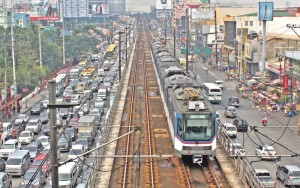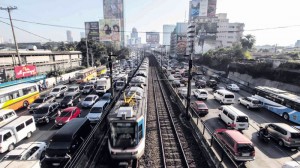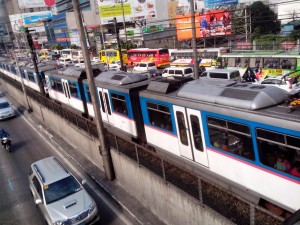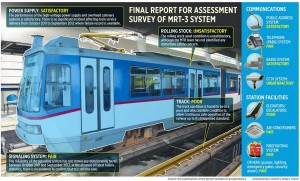by Lorenz S. Marasigan | Business Mirror | November 29, 2014
THE benefits from the planned P54-billion takeover of the Metro Rail Transit (MRT) Line 3 are minimal to nil, its private owner said, as it only provides for the exchange of money from one government agency to another.
Metro Rail Transit Holdings II Inc. (MRTH-II) Chairman Robert John L. Sobrepeña made this comment in line with the Senate’s disapproval of the budget for the train line’s buyout.
He said the multibillion-peso budget is not enough to compensate for the whole train line, as the amount only accounts for the bonds owned by the Development Bank of the Philippines (DPB) and the Land Bank of the Philippines (LBP).
“The P54-billion equity value buyout would not in any way, benefit the maintenance and rehabilitation of the MRT 3 system, but will only be used to retire the bonds already owned by DBP and LBP.
Thus, public money will be transferred from one pocket of the government to another without benefit to the riding public,” Sobrepeña said.
Last month the Senate thumbed down the P53.9-billion budget for the takeover, realigning it to other expenditures for the train line.
Sen. Francis G. Escudero was quoted by news reports as saying that the buyout has “no economic value because the government is buying non-voting shares.”
He was referring to the 80-percent economic interest held by the two government-run banks.
The price of the train line, according to MRTH Vice President Frederick C. Parayno, was already pegged at roughly P110 billion back in 2009, more than double than the fund for the buyout.
The government aims to completely takeover the line by the time President Aquino steps down from office in 2016.
But recent delays, including the “tying up of loose ends,” are forcing the government to double its efforts to effect the buyout.
One of the requirements to execute the takeover is for the government to strike a compromise deal with the private owner of the train line.
This would effectively end the ongoing arbitration case in Singapore that was lodged against the government in 2008, due to its failure, as the operator of the line, to pay billions of equity rentals payment to the owner of the rail system.
Transportation Assistant Secretary Jaime Fortunato A. Caringal, a member of the team handling the buyout, earlier said the State is confident on crafting the agreement with MRT Corp. (MRTC), as government officials make up bulk of the board members of the company.
MRTH-II has an 85-percent equity in MRTC. MRT Holdings Inc., meanwhile, holds the controlling interest in MRTH-II.
Should the buyout be completed in 2016, the transportation agency may then bid out the operations and maintenance contract of the line, thereby tapping private sector efficiency and customer service orientation for operational needs, while retaining regulatory functions for passenger protection with the government. But Sobrepeña maintained that the government’s takeover of the train line is not the solution for the MRT’s persisting woes.
He said the government must ensure the maintenance of the line, while upgrading the obsolete the train system. The businessman urged the state to reinstate the so-called single point of responsibility to allow the company to properly maintain, upgrade, and expand the 15-year-old train system. This, he said, will allow MRTC to undertake under one single contract the maintenance, rehabilitation, and upgrading of the MRT 3 system under the management of the former maintenance provider, Sumitomo Corp.
“The maintenance will not just include corrective measures, but also preventive maintenance and asset management plan as recommended by the MTR Hong Kong in its preliminary audit report.
The rehabilitation to be undertaken will include the immediate procurement of spare parts, replacement of broken and deteriorated rail tracks, and other works necessary to rehabilitate the MRT 3 system,” Sobrepeña emphasized.
He added: “Without prejudice to the pending arbitration proceedings, the upgrading of the MRT 3 system will ensure that the commissioning and eventual operations of the 48 new light rail vehicles to be supplied will be compatible and seamless.”
Sobrepeña was referring to the recently procured train cars from a manufacturer in China, a hotly contested multibillion-peso contract that resulted in the resignation of the general manager of the MRT this year.
“It is our belief that it would be to the best interest of the MRT 3 system and the riding public that the single point of responsibility be reinstated by adding the rehabilitation and upgrading of the system to the contract of the maintenance contractor under a long-term contract,” Sobrepeña said.
Transportation officials did not respon to the BusinessMirror’s request for comment.
Since 2004 the train system has been operating at overcapacity. Currently, the line serves nearly 550,000 passengers per day, it even reached, at one point this year, the 650,000-daily passenger mark. It has a rated capacity of 350,000 daily passengers.





